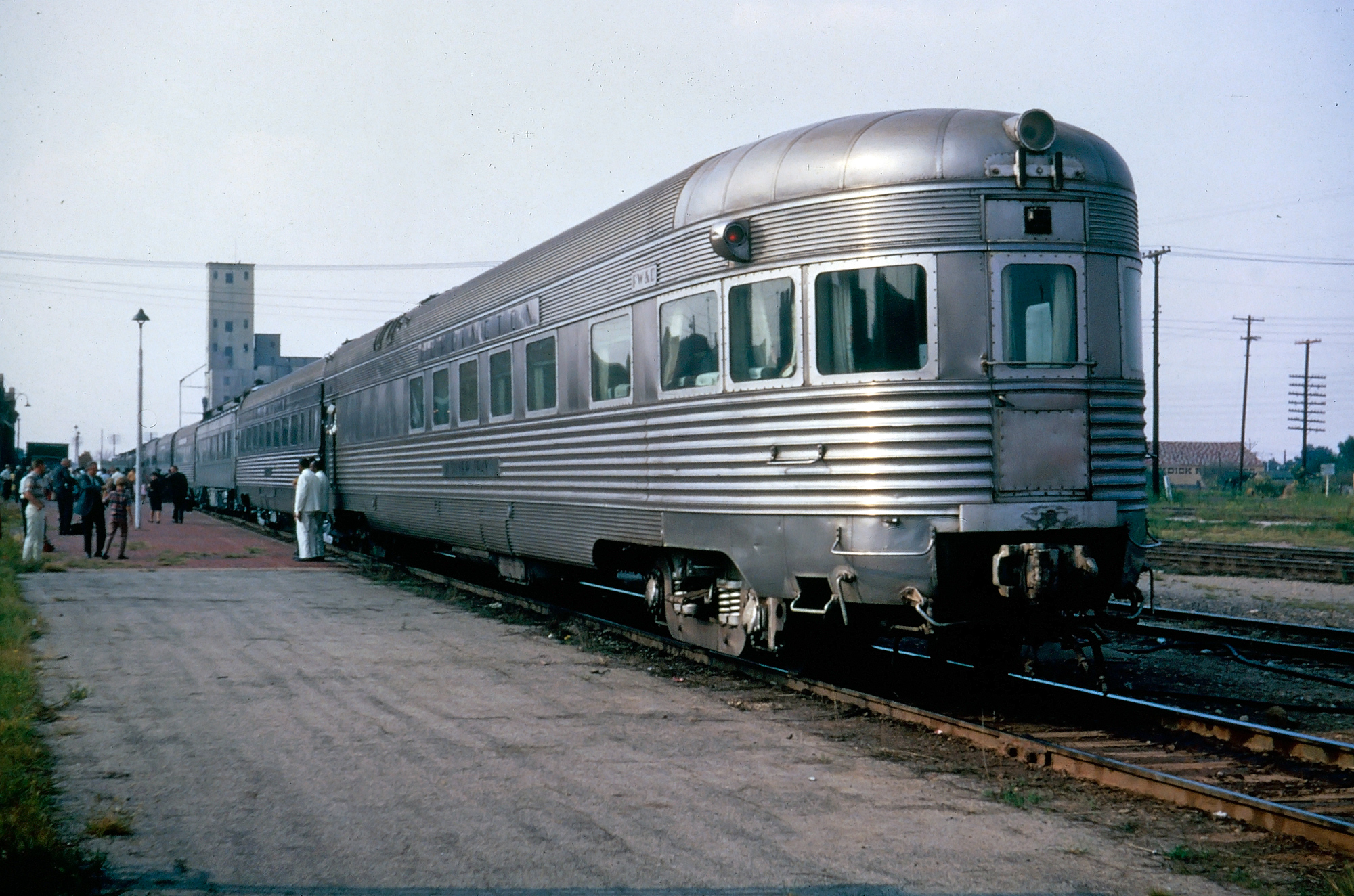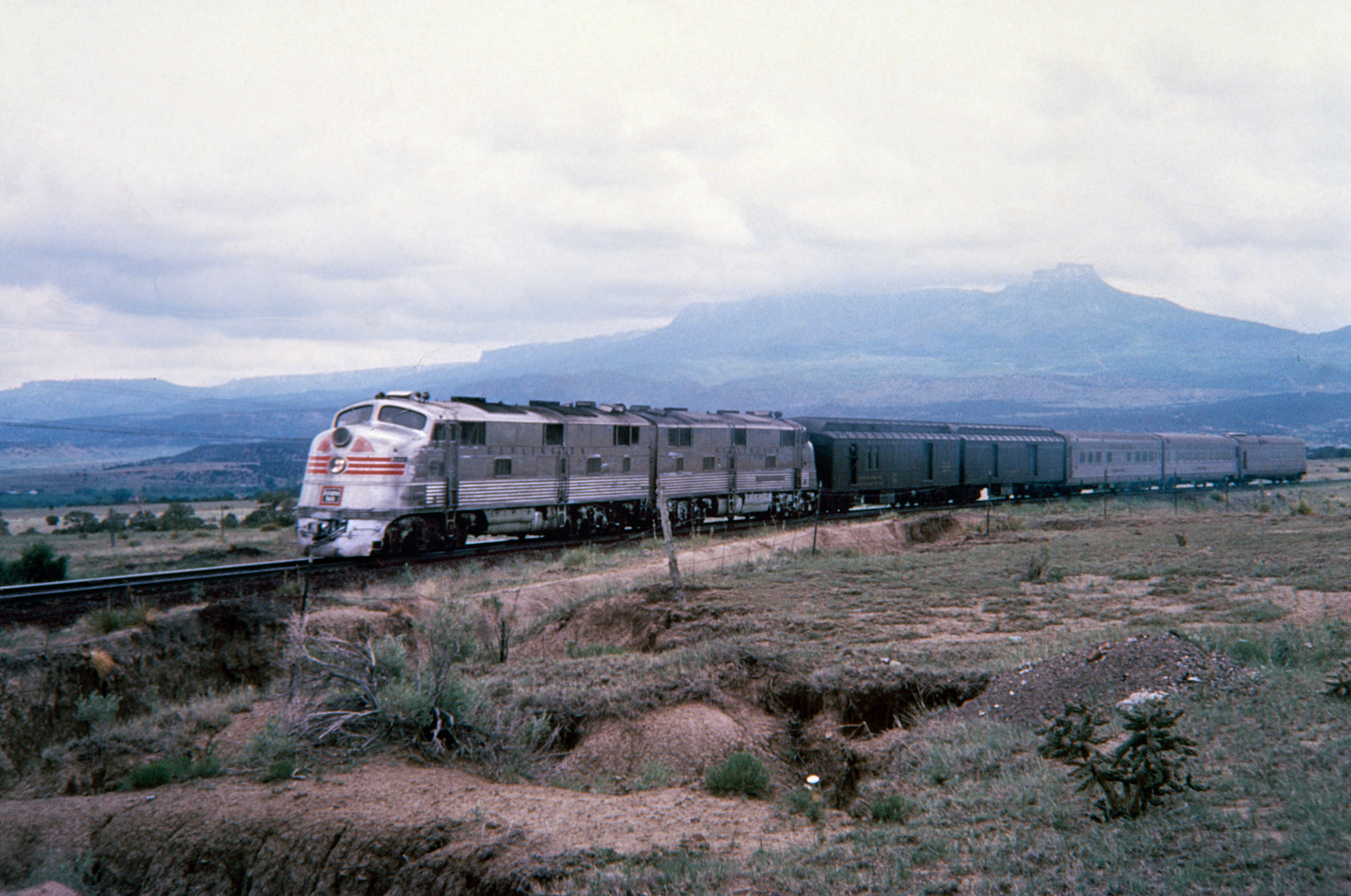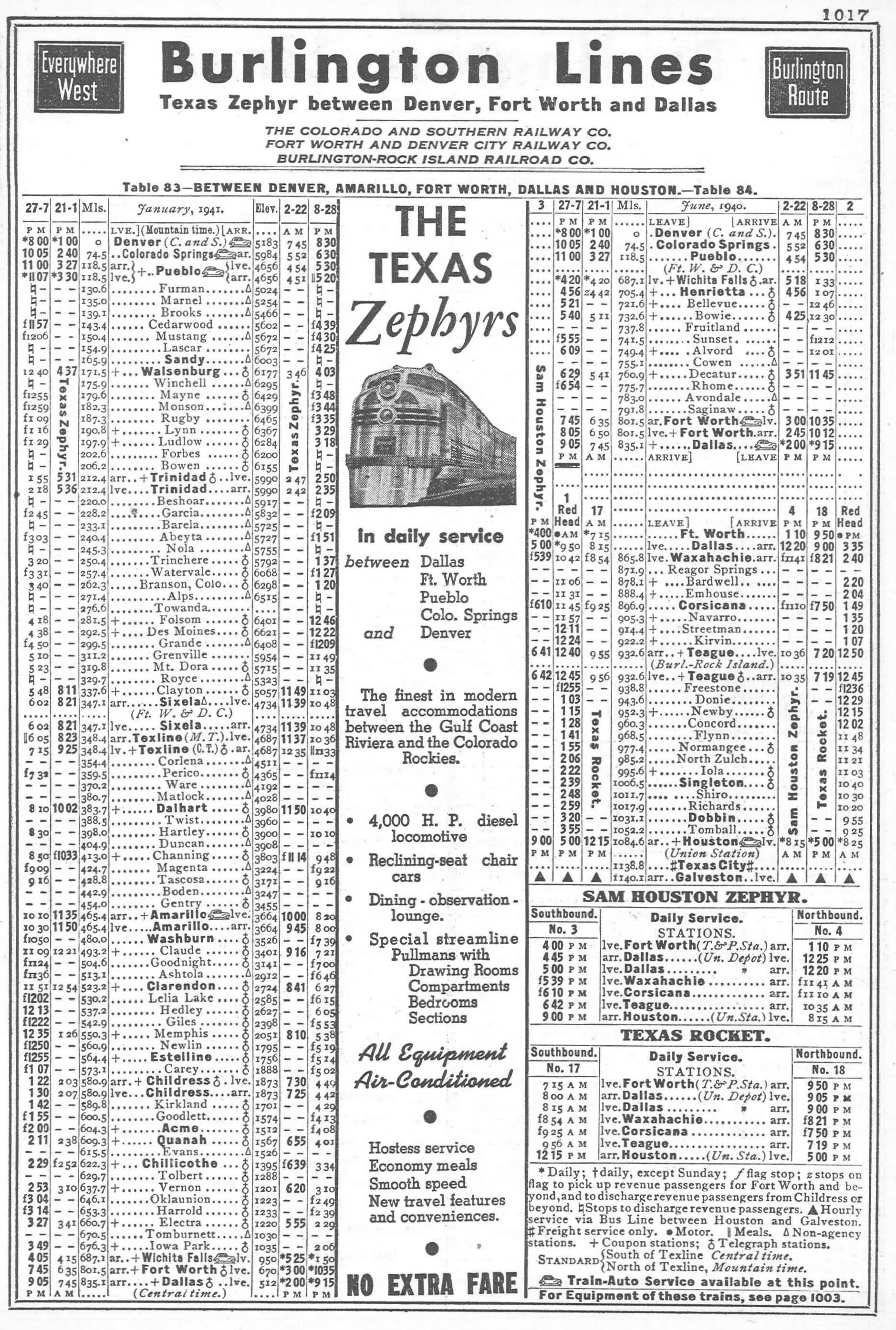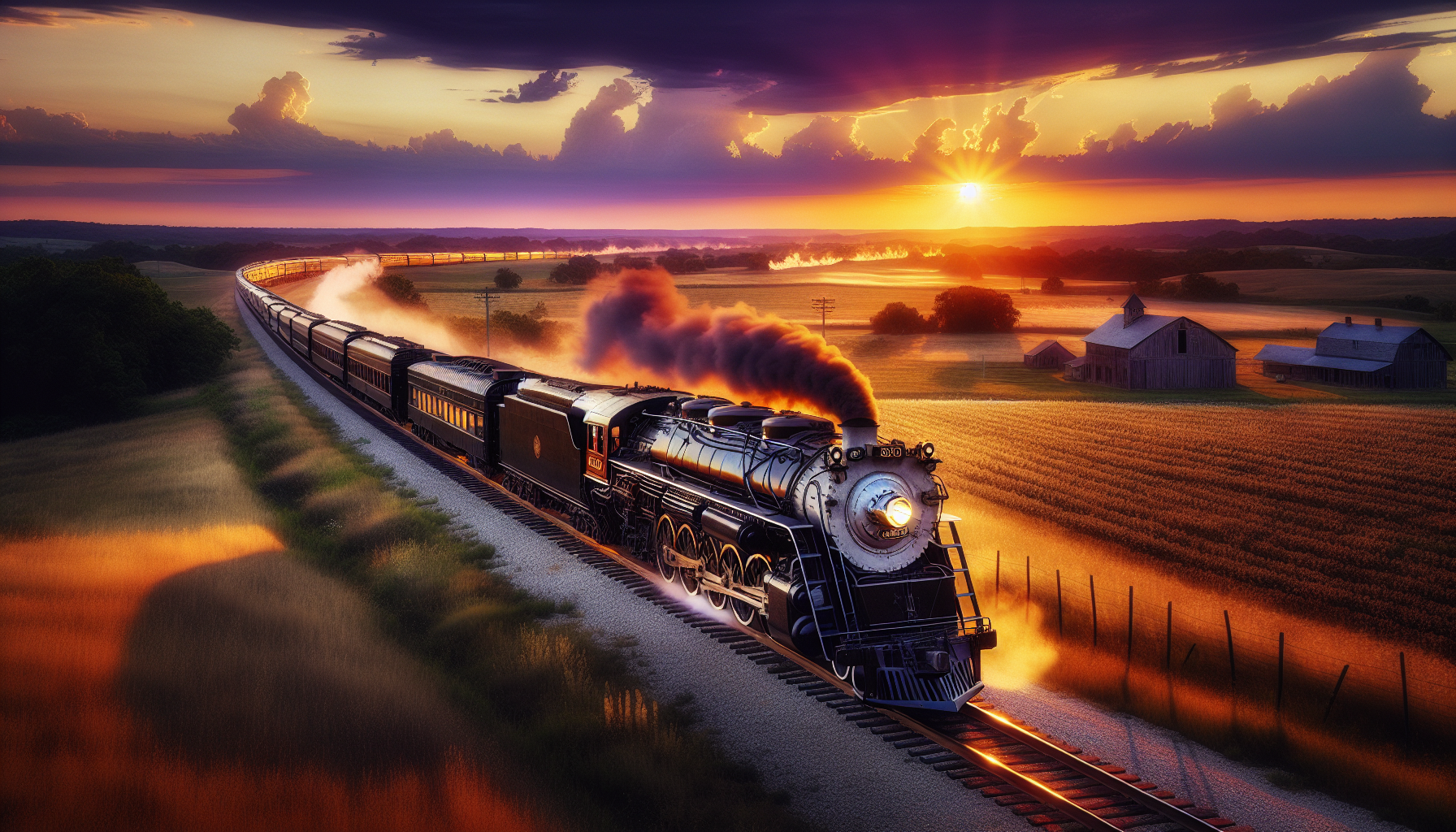"Texas Zephyr" (Train): Consist, Timetable, History
Last revised: February 27, 2025
By: Adam Burns
The Texas Zephyr was a passenger train operated by the Colorado & Southern and the Fort Worth & Denver, both subsidiaries of the Chicago, Burlington & Quincy (CB&Q).
The CB&Q operated a vast collection of Zephyr streamliners - sporting fluted stainless steel equipment from the Budd Company - throughout its 8,800-mile network, which included the Texas Zephyr.
The train operated from 1940 to 1967, providing service between Denver, Colorado, and Dallas, Texas. The train was named after the Greek god of the west wind, Zephyrus, reflecting its route across the western United States.
Photos
 Burlington's (FW&D) car #270, the observation-lounge-diner "Silver Tray," brings up the tail end of the northbound "Texas Zephyr" stopped at Wichita Falls, Texas, circa 1965. American-Rails.com collection.
Burlington's (FW&D) car #270, the observation-lounge-diner "Silver Tray," brings up the tail end of the northbound "Texas Zephyr" stopped at Wichita Falls, Texas, circa 1965. American-Rails.com collection.Chicago, Burlington & Quincy
The Chicago, Burlington & Quincy - usually referred to as simply the Burlington - was a significant railroad company in the United States, operating in the midwestern region from 1849 to 1970.
It was known for its extensive network, connecting Chicago with the western states. The CB&Q was instrumental in the development of the Chicago area and the American West.
It was one of the best managed and most successful railroads in the nation throughout most of the 20th century, containing a somewhat unique network that linked Chicago with Denver, the Twin Cities, Omaha, St. Louis, and Kansas City.
It controlled two notable subsidiaries, the Colorado & Southern and Fort Worth & Denver which provided a direct route from Denver to Amarillo, Dallas/Fort Worth, and Houston/Galveston.
The Burlington was an early proponent of the streamliner movement in an effort to regain lost ridership from the ongoing economic downturn of the 1930s.
Zephyr 9900
It subsequently launched the first diesel-powered streamliner ever put into service, the "Zephyr 9900" (Pioneer Zephyr) in April, 1934. It famously set a speed record when it traveled non-stop from Denver to Chicago on May 26, 1934.
The "Dawn-To-Dusk" run covered a distance of 1,015 miles, in just 13 hours and 5 minutes with an average speed of 78 mph. The trainset is now on permanent display at the Museum of Science and Industry in Chicago, Illinois.
Following the train's instant success the Burlington went on to launch an entire fleet of Zephyrs which included the Afternoon Zephyr, Ak-Sar-Ben Zephyr, American Royal Zephyr, California Zephyr, Denver Zephyr, Kansas City Zephyr, the joint Zephyr Rocket (Rock Island), Morning Zephyr, Nebraska Zephyr, Pioneer Zephyr, and the Sam Houston Zephyr.
In March, 1970, the CB&Q merged with three other railroads to form the Burlington Northern Railroad, which is now part of the BNSF Railway.
Inauguration
The Texas Zephyr was a well-known, streamliner that served the Burlington's C&S and FW&D lines between Denver and Dallas.
The new streamliner began service on August 22, 1940, replacing the slower, less glamorous heavyweight Colorado Special, and introducing a new era of streamlined rail travel to this bustling route.
The transition from the Colorado Special to the Texas Zephyr symbolized a critical paradigm shift in regional rail travel, favoring sleek designs and high-speed capacities.
As Mike Schafer and Joe Welsh note in their book, "Streamliners: History Of A Railroad Icon," the C&S and FW&D marketed the new train as "The fastest, finest train service ever enjoyed between Texas and Colorado."
The streamliner transformation ushered in monumental advancements, providing faster, stylish, and more efficient travel for thousands of passengers.
Consist (2/1941)
From station to station, the Texas Zephyr connected the cities of Denver, Colorado, and Dallas, Texas. This route included significant stops such as Colorado Springs, Pueblo, Trinidad, Amarillo, Wichita Falls, and Fort Worth before making its final glide into Dallas..
In terms of identities, the Texas Zephyr was listed as #1 (southbound) and #2 (northbound) on the Colorado & Southern, carrying these recognizable designations throughout its operational timespan.
 A pair of Burlington E5A's have the northbound "Texas Zephyr" just north of Trinidad, Colorado. Based on the paltry consist, this scene was probably taken in the mid-1960s, shortly before the train was discontinued. American-Rails.com collection.
A pair of Burlington E5A's have the northbound "Texas Zephyr" just north of Trinidad, Colorado. Based on the paltry consist, this scene was probably taken in the mid-1960s, shortly before the train was discontinued. American-Rails.com collection.Onboard Services
The onboard services offered were reflective of a golden era of rail travel, offering a 'De Luxe' chair cars, Pullman sleepers (including drawing rooms, compartments, double bedrooms, and sections), and a diner-observation-lounge. Famed for their high standards, the Texas Zephyr offered a fine dining experience, setting it a class above many of its contemporaries.
The manufacturing giant behind the creation of the Texas Zephyr's passenger cars was the Budd Company, renowned for their experience in railcar design.
The company created a set of sleek, stainless-steel equipment that held the spirit of the streamlined era within their metallic structures.
The train was led by Electro-Motive's early E5 streamlined diesels. This model was unique to the Burlington and its subsidiaries, carrying similar fluted stainless steel to match the Budd equipment.
Between the extreme ends of Denver and Dallas, the Texas Zephyr traveled 835 miles, offering passengers an unparalleled voyage through the heart of America.
Upon reaching Dallas, the Texas Zephyr offered connections with the the Sam Houston Zephyr and Texas Rocket - both jointly operated by the Burlington-Rock Island Railroad - for through service to Houston/Galveston.
Final Years
By the late 1960s, the popularity of rail travel was overshadowed by emerging modes of transport including commercial airlines and personal automobiles. This competition, married with internal management issues, led to the last Texas Zephyr journey being made on September 11, 1967.
Timetable (2/1941)

While its tracks may have been silenced, the legacy of the Texas Zephyr lives on, inspiring rail enthusiasts and historians alike. This streamlined train is remembered not only for its sleek design and efficient service but also for its role in ushering in a new era of rail travel - one marked by speed, style, and a sense of adventure.
The train's fascinating tale is, after all, more than a story about a train service. It is a testimony to a time when railroads were the arteries of a nation in constant motion, faithfully transporting millions every day. Its legacy will indeed roll on, as long as the lure of the rails continues to enchant future generations.
Contents
Recent Articles
-
New York Father's Day Train Rides: A Complete Guide
May 11, 25 03:57 PM
If you’re looking to make this day memorable, consider taking a scenic train ride with your dad through the beautiful landscapes of New York State. -
Missouri Father's Day Train Rides: A Complete Guide
May 11, 25 02:57 PM
If you're looking for a unique way to honor your dad this year, why not consider a scenic and historical train ride? -
Maryland Father's Day Train Rides: A Complete Guide
May 11, 25 02:22 PM
Maryland offers some unique and picturesque train rides, including the Walkersville Southern that celebrates dad each June!



